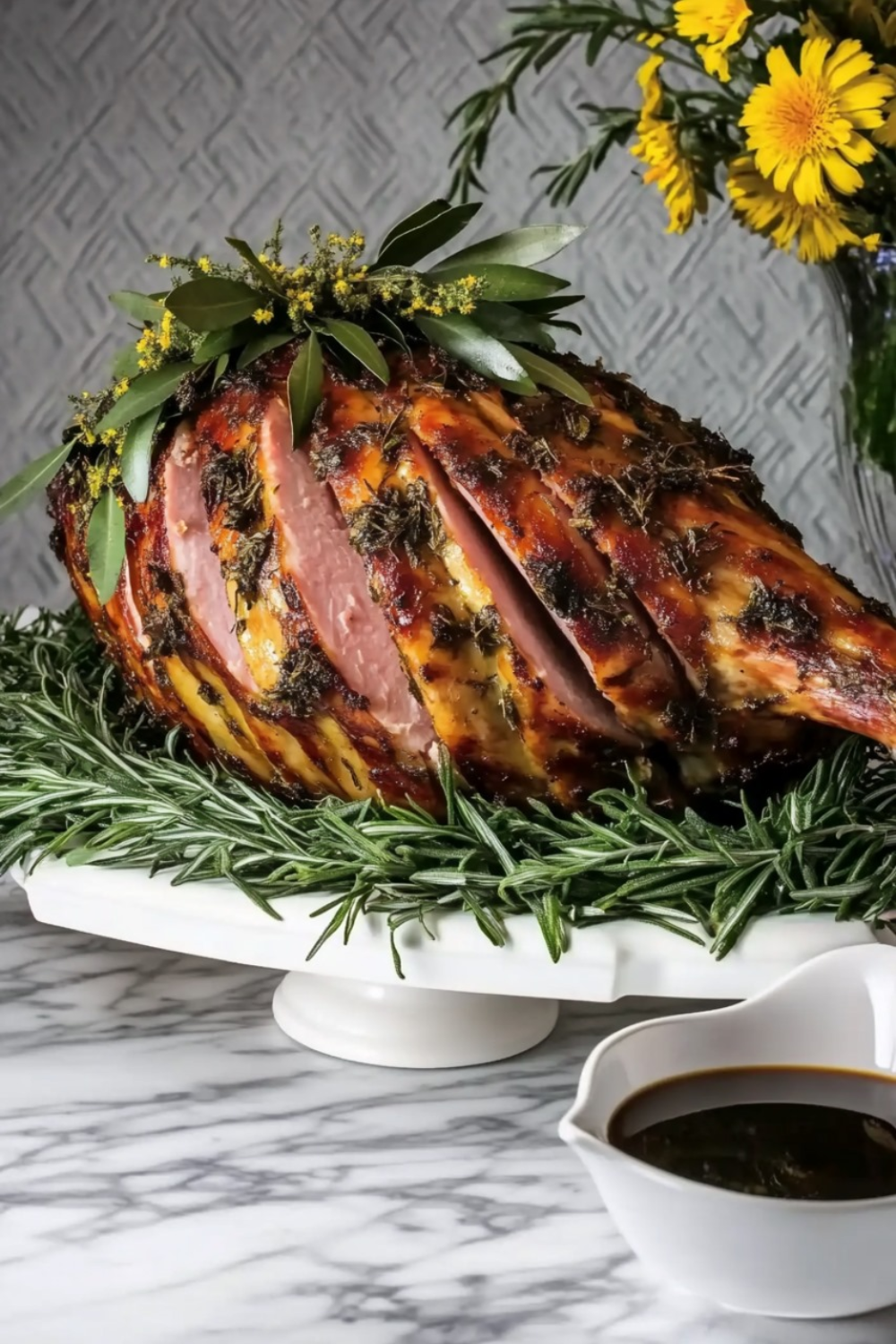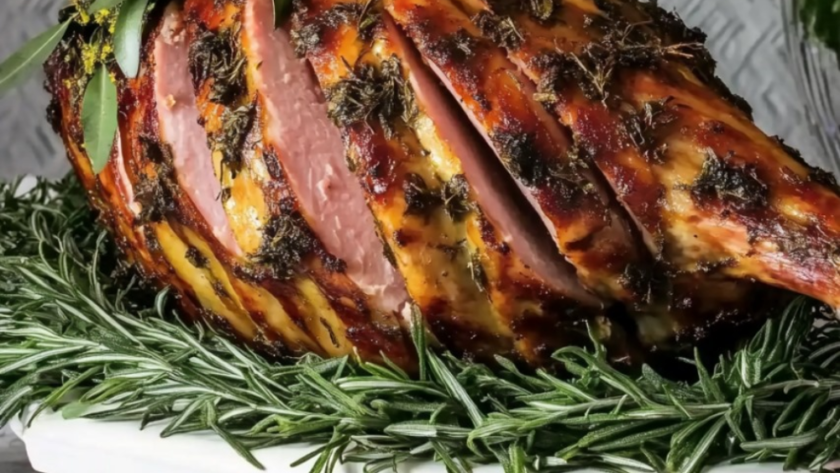I didn’t mean to make a ham.
The fridge was too full, the radiator was clanging, and Mae texted “any meat???” like I was a butcher with reception. The ham had been in the bottom drawer since the storm and I kept pretending not to see it.
But the oven was still hot from earlier.
And I couldn’t think straight.
So I started.
There was rosemary in a mug on the sill from that time I thought tea would calm me.
There was garlic. Always is.
There were regrets. Also permanent.
So I found the page — Her Highness’s Fresh Ham with Green-Herb Paste. Folded, faint grease bloom on the edge. Felt ceremonial. Or foolish.
What Her Version Looks Like
Martha’s version is… composed.
A whole fresh ham, twenty-something pounds like it’s no big deal. Scored and jeweled with garlic and rosemary tufts, sitting upright like a ship being christened.
She layers onions in rounds like coins, makes a herb paste like a forest floor in a blender, pours white wine in stages like she’s seasoning memory.
There’s a bay leaf wreath.
I didn’t do that.
I tried. It looked like a sad bracelet.
Her instructions say to rub, baste, pour.
To tie it just so.
To wait for the paste to melt into the skin like grace.
She calls for dandelion greens at the end.
I laughed out loud.
What I Did Differently (and Why I’m Not Sorry)
I didn’t tie it.
I mean, I tried. But the twine snapped and I wasn’t about to wrestle an 18-pound grease bomb on a Tuesday.
Also—I swapped the oregano for thyme. Not because I meant to, but because the oregano in my fridge had become… philosophical.
And I added lemon zest to the herb paste. Not Martha-approved, but I needed the brightness. Everything had been too gray lately. Inside and out.
The Way It Happened in My Kitchen
Started with garlic. Always do.
Mae said once, “you cook like a vampire slayer.” I took it as love.
The rosemary needles were sticky and strong. I pulsed them with the garlic, olive oil, a handful of thyme that smelled like old summer. The paste came out swampy, but alive.
The ham was heavier than I remembered. I dropped it once—just a thud, not a crash—but it made the dog bark and I almost cried.
I scored it with a dull knife. Diagonal, then across. Got distracted halfway through thinking about the time Mae tried to braid her hair like a basket. The slits weren’t even. The garlic slivers didn’t all stay in. Some of them popped back out like they knew better.
I rubbed the paste in with my hands.
Not elegant. But real.
And the onions—well. I only had three. One had sprouted. I used it anyway. I layered them, added the rosemary I hadn’t steeped in tea, shoved bay leaves in like I was stuffing a letter I didn’t want to send.
Poured the wine and closed the door.
Didn’t look back for an hour.
The kitchen smelled… ancestral. Like I was doing something that mattered. Or pretending to.
Halfway through roasting, I basted it with a spoon. I didn’t measure the wine again. Just poured until it hissed and steamed and made me feel slightly more in control.
The dented Dutch oven from the divorce sat on the back burner. I tapped it once, mid-baste. Reflex.
A Few Things I Learned
It needs time.
And smell.
And not caring too much about the bay leaves.
Also—don’t discard the onions like she says. I kept mine. They were jammy and sweet and made me feel less alone.
What I Did With the Extras
Gave some to Mae. She called it “meaty herb cake” and said it needed mustard.
I stood at the counter that night and tore off pieces like bread. No plate. Just hands.
Wrapped the bone in foil and forgot it in the fridge until Friday.
Would I Make It Again?
Maybe.
If someone needed feeding.
If I was angry and had rosemary.
If the oven was already on.
That’s As Much As I Remember
The scent stuck to my sleeves.
The dog slept near the oven like it was giving off comfort.
It felt louder than it should’ve been.
I slept hard that night.
If you need something messier, I did a version of Martha’s cheesy leek bake last winter that nearly broke the oven—but worth it.

FAQs
Yep. Honestly, It Tastes Even Better The Next Day. I Sliced It Cold Once, Standing Barefoot In The Fridge Light. No Complaints.
Don’T Spiral. Use A Bone-In Roast, Even A Smaller One. The Paste Works On Pork Shoulder Too. Just Adjust The Cook Time And Trust Your Nose.
Technically? Maybe. Emotionally? No. I’Ve Made It With Just Rosemary And Lemon When The Store Was Out Of Everything Else And It Still Sang.
Sure. Wrap It Tight, Label It Like You Won’T Forget, Then Find It Three Months Later And Thank Past-You. It’Ll Be Softer, But Good For Soup Or Sandwiches.
Use Broth. Or Water. Or That Half-Drunk Bottle Of Cider From Your Fridge. The Ham Doesn’T Care. It’Ll Still Taste Like Effort.
Check out More Recipes:
Martha Stewart Fresh Ham With Green-herb Paste
Description
A Forest-Scented Ham That Fed More Than Just My Stomach.
Ingredients
Instructions
- Make the Green-Herb Paste:Throw 3 heads of peeled garlic, a couple big handfuls of fresh rosemary needles (I didn’t measure—maybe a cup?), and thyme instead of oregano (the oregano had curled in on itself) into a food processor. Add about 1 tbsp coarse salt, maybe a little more if the day felt dull, and a heavy grind of black pepper. Pulse it. Then slowly pour in ¾ cup olive oil (mine was cheap but forgiving) while it runs. It should look swampy but alive—textured, not baby food. I added zest from one lemon, because the room needed brightness. Keep it in a jar in the fridge. Overnight is fine.
- Prepare the Ham:Heat the oven to 160°C / 325°F, rack low. Line the bottom of your largest roasting pan with 3 sliced onions (I only had three, one had sprouted—used it anyway). Scatter 8 or so rosemary sprigs and as many bay leaves as you can find (I didn’t count). This is your bed. It should smell like intention.
- Score and Season the Ham:Take your whole fresh ham—mine was just under 19 lbs, still cold—and score the skin in a diamond pattern. Deep enough to make it matter. At the cross-sections, wedge in slivers of garlic and small rosemary tufts. It’s messy. That’s okay. Rub on ½ cup of your herb paste. Really press it in. The fat will resist. Keep going. Salt generously. Pepper with purpose. Don’t flinch if it looks uneven.
- Tie and Rest the Ham:I tried to tie it. I did. The twine snapped and I swore. Tied it loosely in two places and left the bay leaf crown for Her Highness—I couldn’t manage it. Let the ham sit out for 30–40 minutes until it stopped feeling cold and accusing.
- Roast the Ham:Slide it into the oven and leave it be for an hour. Then, pull it out, whisper to it, and pour ¾ cup white wine over the top. The wine should hiss. Rub more of the herb paste into the cracks. The fat will have opened like it’s telling you a secret. Keep roasting for another 4 hours or so—mine took about that. Every hour, baste with more wine, more paste, maybe some pan juices. If it gets too brown too fast, throw foil over the top like a tired apology. Use a thermometer if you trust them—it should read 145–155°F in the thick middle, not near the bone. I tapped the Dutch oven next to it once or twice. Habit.
- Rest and Serve:When the kitchen smells like rosemary and decisions, pull the ham out. Let it sit. The temperature will climb while you breathe. When it’s cool enough to face, transfer it to a platter and remove the twine (or what’s left of it). I didn’t use dandelion greens. That felt performative. Let it rest another hour or so—more if you’re tired. It slices easier when the urgency is gone.
- Make the Pan Sauce:Don’t discard the onions. I know Martha says to—but I kept them. Ate them cold the next day like candy. Pour the pan liquid into a fat separator if you’ve got one. If not, close your eyes and skim with a spoon like I did. Put the pan over high heat. Add ½ cup water and scrape all the good bits off the bottom. Reduce it until it feels more like gravy than regret. Strain it if you want. I didn’t.
Serve with mustard. Or just silence.
It’s good either way.
Notes
- Score the Skin Deeply Enough: When scoring the ham, make sure your cuts go through the skin and fat but not into the meat. This helps the fat render properly and creates a crispy, golden crust.
- Use Room Temperature Ham: Let the ham sit out for 30 minutes before roasting. Cooking it straight from the fridge can lead to uneven cooking.
- Baste Regularly: Basting with wine and herb paste every hour keeps the ham moist and infuses it with flavor. Don’t skip this step!
- Check Temperature Carefully: Use an instant-read thermometer and avoid touching the bone when checking for doneness. The center should read 63–68°C / 145–155°F.
- Rest Before Slicing: Let the ham rest for 1–1.5 hours after roasting. This allows the juices to redistribute, making the meat tender and easier to slice.
